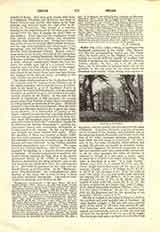

Cedar [ARZ (erez), kedros, cedrus], a coniferous tree frequently mentioned in the Bible. The Hebrew erez, like the corresponding Arabic arz, the Greek kedros, the Latin cedrus, or the English cedar, may be applied to several different species of conifers, but usually it designates the celebrated cedar of Libanus (Cedrus Libani). In Lev., xiv, 4, 6, 49, 52, and um., xix, 6, the cedar of Libanus seems out of the question, as the tree must be one whose wood the Israelites could readily obtain during their sojourn in he desert, which is plainly not the case with the cedar of Libanus. Juniperus Phoenicea, a species of juniper which is found in the Arabah, and probably also in the adjoining Sinaitic Peninsula, and whose wood, like that of the cedar, possesses aromatic properties, is most likely the tree meant in these texts. In Num., xxiv, 6, too, the cedar of Libanus, which thrives best on high, dry ground, can hardly be intended, unless, as has been suggested, the terms of comparison in the last two members have been accidentally transposed. In all the other passages the cedar of Libanus is referred to, though in a few cases a doubt might be raised as to whether it is meant exclusively. The cedar is described as a tree “of a high stature” (Ezech., xxxi, 3; Is., ii, 13; xxxvii, 24; IV K., xix, 23), whose “height was exalted above all the trees of the country” (Ezech., xxxi, 5; cf. Judges, ix, 15; III K., iv, 33; IV K., xiv, 9; Amos, ii, 9). It is “the cedar of God” (Ps. lxxix, 11), the tree of the Lord which He has planted [Ps. civ, 16 (Hebr.)]. It is the type of strength [Ps. xxviii, 5; Job, xl, 12 (Hebr. 17)], the symbol of lofty pride (Ps. xxxvi, 35; Is., ii, 13), the emblem of greatness and power (Jer., xxii, 7; Zach., xi, 2), and of surpassing excellence (Ecclus., xxiv, 17). It is the “glory of Libanus” (Is., lx, 13), “most beautiful for his greatness and for the spreading of his branches” (Ezech., xxxi, 3, 6, 7).
All this is verified in the cedar of Libanus, which is the stateliest and most majestic tree of Palestine. It often reaches a height of 100 feet and more, and the girth of the trunk in old trees may exceed 40 feet. The branches, with their numerous ramifications, spread out horizontally and are of such size that not infrequently the spread of the tree exceeds its height. The leaves are dark green and grow in tufts like those of the larch, but unlike these they persist through the winter. The wood is reddish-white, fragrant, and close-grained, at least in older trees. Moreover, by reason of the resinous oil with which it is impregnated, it is proof against dry-rot and worms, and in consequence is extremely durable. Pieces found by Layard in the ruins of the palace of Assur-nasirpal were still in a good state of preservation after 2700 years. These qualities caused it to be much sought for building purposes. It was extensively used in the palaces built by David and Solomon, and especially in the first Temple (II K., v, 11; vii, 2; III K., v, 6; vi, 9 sq.; vii, 2 sq.). It was also used in the second Temple (I Esd., iii, 7). Because of its close grain and lasting qualities, statues and images were fashioned out of it (Is., xliv, 14, 15; cf. Pliny, “Hist. Nat.”, XIII, ii). Young trees were made into masts (Ezech., xxvii, 5). The statement that the cedar is unsuitable for masting rests on insufficient observation; in dense growths trees suitable for masts are not uncommon. There is no reason, then, why, in the last text, “cedars from Libanus” should be referred to the Aleppo pine, which, moreover, is not special to the Libanus and could have been obtained by the Tyrians nearer home. The large forests of cedar-trees which once adorned Libanus, and from which the Hebrews drew the wood, have almost entirely disappeared. They were laid under contribution by Phoenician and Hebrew Egyptian and Assyrian, Greek and Roman, till only a few (eleven) small groups of trees remain. The most important and best-known is situated below the summit of Dahr el-Qodfb, the highest peak of the chain, four miles from Besherre. Here are found about 400 trees, among which are some ten venerable patriarchs probably about 2000 years old, more remarkable, however, for their girth of trunk than for their height. Extensive forests exist farther north in Mt. Amanus and Mt. Taurus. There are two other varieties of cedar, considered by some botanists as distinct species; namely, Cedrus deodara, or deodar-tree, a native of the Himalayas, and Cedrus Atlantica, growing in the Atlas mountains.
The cedar is often used in Scripture for figures and comparisons. Besides the uses already indicated the following may be mentioned. Because of its luxuriant growth and length of life it is an emblem of prosperity (Ps. xci, 13), and because of its stateliness it is a figure of beauty and majesty (Cant., v, 15; Ecclus., 1, 13). It is also used as the symbol of the Messias and His kingdom (Ezech., xvii, 22 sq.).
F. BECHTEL

